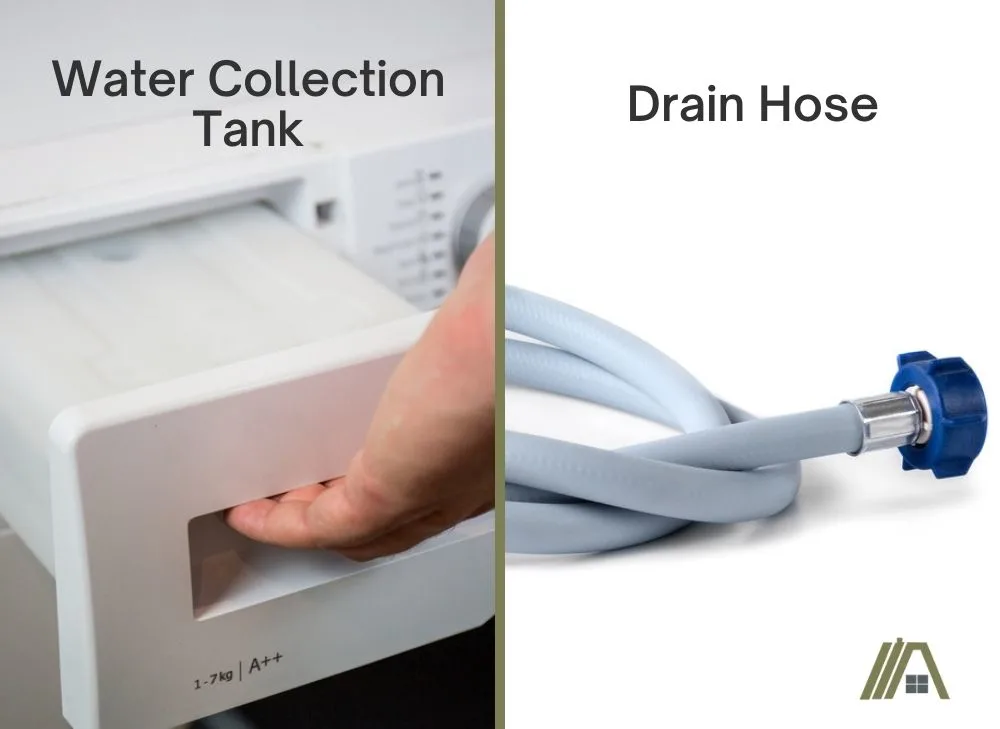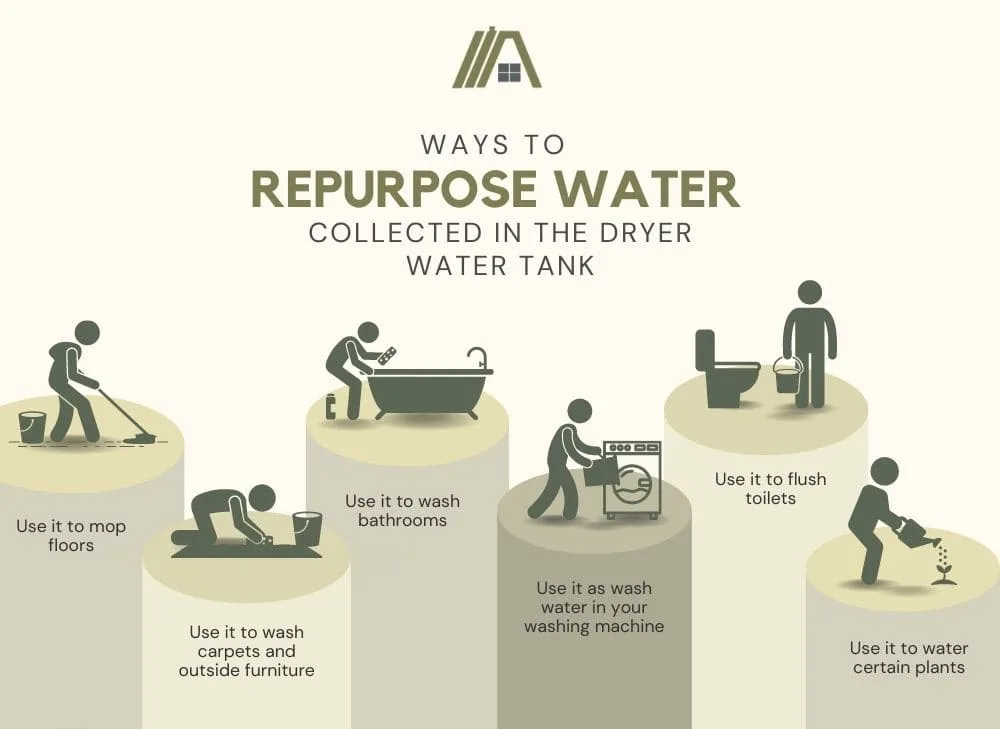A dryer removes water from clothes. Vented dryers exhaust the water outside in the form of steam. As ventless dryers do not have vents, many people are concerned that the moisture is just released into the house. This is a myth, but the water does have to go somewhere.
A logical guess would be that these appliances collect the water from the air and dispose of it via a drain like a washer or a dishwasher. Maybe one day, this will be the default method of water removal, but currently, ventless dryers have collection tanks that require manual emptying. A few have the option of a hose that can pump water out into a drain.

Ventless dryers don’t need drains. They condense evaporated moisture, collecting the water in removable tanks to be manually emptied. Some models also have a hose that can be used to pump the water into a nearby drain. In such cases, drains are convenient but not critical to the dryer’s function.
Most Ventless Dryers Don’t Require Drains
Unlike dishwashers, all ventless dryers are designed to function without any interaction with the outdoors. This means that they can function without vents and drain pipes.
There are two ways a ventless dryer can get rid of moisture:
- Water collection tank.
- Drain hose.

Unlike vented units that exhaust humid air to the outdoors, ventless dryers use a heat exchanger to extract the moisture from hot air and then move the water to a water collection tank. Basically, heat is extracted from the air leaving the drum. This means that the water condenses out (cold air cannot hold as much moisture).
By default, the water from the dryer goes to the water container. However, if your model comes with the drain hose option and you’d like to use it, you would have to first connect the hose to the dryer.
So, a drain is not necessary for any ventless dryer to function because they all come with a water collection tank. Nearby drains can be used with the drain hose to increase the convenience of emptying the water.
How to Empty the Water Collection Tank
Emptying the water collection tank of a ventless dryer is pretty easy.
The first thing you’d have to do is locate the tank. The water tank of most ventless dryers is located in a compartment on the top layer of the dryer. However, it could also be positioned at the bottom of the machine. A quick look at your user manual will help you to locate the tank without any issue.
Here is how to empty the water collection tank in your ventless dryer.
- Carefully pull out the tank from its compartment. Rest assured, it should not be an open-topped affair that will spill everywhere as soon as it is tipped a little to one side!
- Dispose of the water or repurpose it to suit your household needs.
- Insert the water container back into its housing, ensuring that it is installed properly.
Failing to empty the tank when it’s full can cause your dryer to stop running in between cycles. However, this is only temporary and the unit would resume working normally once the tank is emptied.
This is actually a great feature to have. Older models without this will overflow and leak water all over your floor as punishment for forgetting to empty the tank.
How Often Will the Tank Need to Be Emptied?
How much water accumulates in the tank is dependent on factors like the quantity of laundry, the porosity of the fabric, and how damp the clothes are when you put them into the dryer.
Most ventless dryers on the market right now feature an indicator that would alert you whenever the tank is full. This way, you would be less likely to forget to empty the tank.
However, if your dryer doesn’t have an indicator, it’s recommended that the water tank be emptied after every completed load. This way, the tank isn’t at risk of getting filled in the middle of a cycle.
Some Dryers Come With a Drainage Hose
As you now know, some ventless dryers come with a drain hose, which can serve as an alternative to the water collection tank.
For most ventless dryers, the connector for the drain hose is located at the rear of the dryer.
Connecting a drain hose redirects the moisture that has been extracted from the air leaving the drum so that it does not move into the water collection tank. However, before fitting the drain hose, you should first confirm that there is a drain close by.
How To Set Up the Drainage Hose
Once you’ve located the hose connector and have a nearby drain where the water can go, the process of setting up the drainage hose is pretty straightforward.
Before setting up the drain hose, you have to first identify where you want to water to drain. Here are some options to choose from:
- Drain the water into a washbasin.
- Drain the water to a sink drain outlet.
- Drain the water to a drainage system used by other devices, like the washing machine.
Steps (these are general steps, for the specific method, you can consult your user manual):
- Locate the drain hose connector at the back of the dryer.
- Insert one end of the hose into the connector.
- Pull the hose through the hose guide.
- Connect the other end of the hose to a drain. If you link the drain to an external drain system, ensure that you use a non-return valve.
To ensure that the water drains properly, make sure the hose isn’t kinked.
A Drain Nearby Will Be Convenient
Manually emptying the water tank after every load could get exhausting, especially if you are drying multiple loads of washings in a day. This makes having a nearby drain convenient.
A drain hose eliminates the need to repeatedly travel back and forth to empty the water containment tank. Once the drain hose has been set up, it allows water to drain with little to no effort from you, even if your clothes are split into multiple loads.
So, even if you connect the hose to a washbasin and decide to detach it after you’re done, you’d only have to remove the hose after you’ve dried all your clothes.
For most ventless dryers, the drain hose that comes with the unit is usually not longer than 5 feet. So, if you need a longer hose or would like to replace the drain hose, you might have to purchase a drain kit (amazon link) that matches your dryer model.
Consider Recycling the Water
If you’re keen on climate positive practices, then recycling the water from your dryer tank is definitely something you should consider. The practice is also beneficial for people that live in drought-stricken areas or communities that experience water shortages.
Here are some ways you can repurpose the water collected in your water reservoir tank.
- Use it to mop floors.
- Use it to wash bathrooms.
- Use it to flush toilets.
- Use it to wash carpets and outside furniture.
- Use it as wash water in your washing machine.
- Use it to water certain plants. However, care must be taken while repurposing the water for this purpose because the water often contains chemicals that make it unfit for usage on certain plants.

It should be noted that the water from your dryer tank must never be used on kitchen utensils and edible items.
Sources
https://www.reviewed.com/laundry/features/everything-you-need-to-know-about-ventless-dryers
https://www.youtube.com/watch?v=AGpyrT2cfu8
https://www.youtube.com/watch?v=PP108H5HpG8
https://www.uakc.com/blog/is-a-ventless-dryer-a-good-choice-for-your-home/
https://www.coolblue.nl/en/advice/heat-pump-dryer-or-condenser-dryer.html

